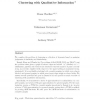Free Online Productivity Tools
i2Speak
i2Symbol
i2OCR
iTex2Img
iWeb2Print
iWeb2Shot
i2Type
iPdf2Split
iPdf2Merge
i2Bopomofo
i2Arabic
i2Style
i2Image
i2PDF
iLatex2Rtf
Sci2ools
FOCS
2003
IEEE
2003
IEEE
Clustering with Qualitative Information
We consider the problem of clustering a collection of elements based on pairwise judgments of similarity and dissimilarity. Bansal, Blum and Chawla (in: Proceedings of 43rd FOCS, 2002, pp. 238–47) cast the problem thus: given a graph G whose edges are labeled “+” (similar) or “−” (dissimilar), partition the vertices into clusters so that the number of pairs correctly (resp. incorrectly) classified with respect to the input labeling is maximized (resp. minimized). It is worthwhile studying both complete graphs, in which every edge is labeled, and general graphs, in which some input edges might not have labels. We answer several questions left open by Bansal et al. and provide a sound overview of clustering with qualitative information. Specifically, we demonstrate a factor 4 approximation for minimization on complete graphs, and a factor O(log n) approximation for general graphs. For the maximization version, a PTAS for complete graphs was shown by Bansal et al.; we give ...
| Added | 04 Jul 2010 |
| Updated | 04 Jul 2010 |
| Type | Conference |
| Year | 2003 |
| Where | FOCS |
| Authors | Moses Charikar, Venkatesan Guruswami, Anthony Wirth |
Comments (0)

